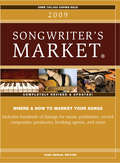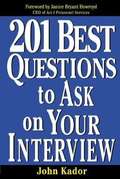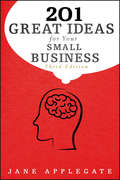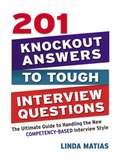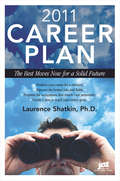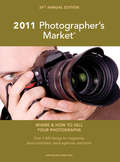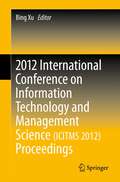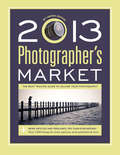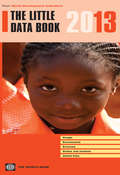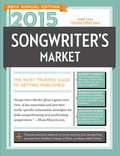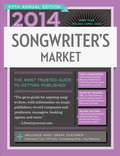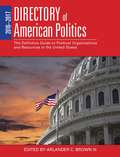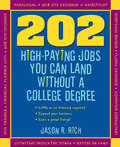- Table View
- List View
2009 Songwriter's Market® (Market)
by Greg HatfieldSongwriter's Market is packed with insider information about the music industry that can spell the difference between success and failure. You'll find support and encouragement through listings for support organizations, online resources, as well as articles and interviews with industry insiders. With completely updated listings for music publishers, record companies, managers, booking agents, and record producers, as well as information about how the music industry works and how to protect yourself from the scam artists of the industry, this helpful guide is every musician's best friend.
201 Best Questions to Ask On Your Interview
by John Kador<p>Asking the right questions can help job seekers ace the interview and land that job. The most critical question job interviewers ask is often the last one. That's when they lean forward and say, "Do you have any questions?" As author John Kador points out, that's the applicants' moment to shine, to demonstrate that they have done their homework and that they're good fit with the organization. Most of all, it provides an applicant with an opportunity to ask for the job. <p>A powerful resource for vast and growing numbers of job seekers, this book fills readers in on the pivotal questions they need to ask to ace the interview. With chapters organized around major themes, such as "the company," "the job," and "the community," <i>201 Best Questions to Ask on Your Interview</i> not only supplies readers with the right questions for virtually every context but also coaches them on the right ways to ask them.</p>
201 Great Ideas for Your Small Business
by Jane ApplegateCompletely revised and updated edition of this very popular and successful small business book The first edition of 201 Great Ideas for Your Small Business was hailed by management guru and author Tom Peters as "Brilliantly researched. Brilliantly written. A gem of priceless value on almost every page. Read. Inhale. Absorb. Great Stuff!" In this completely updated third edition of 201 Great Ideas for Your Small Business, renowned small-business expert and consultant Jane Applegate shares new, powerful, creative, simple, and proven approaches for building a better small business. Details how business owners can use online marketing and social networking more effectively Offers timely strategies for thriving in challenging economic times Includes scores of real-life success stories and all-new interviews with small-business owners, experts, and VIP's including Guy Kawasaki, Kay Koplovitz, and Michael Bloomberg It may be small, but your business is a big deal to you, your customers, and employees. 201 Great Ideas provides lively, practical strategies to help you manage, grow, and promote your business.
201 Knockout Answers to Tough Interview Questions: The Ultimate Guide to Handling the New Competency-Based Interview Style
by Linda MatiasThis useful resource will help you gain a storehouse of sample interview answers that consistently highlight your ability in these areas.Employers today are using increasingly tough interview questions to evaluate candidates based on key competencies and determine how well they think on their feet. To stand out in these competency-based interviews, job seekers must be prepared with situation-specific examples and answers to questions that highlight their accomplishments, knowledge, and abilities--and clearly display how all three meet their potential employers&’ needs.In 201 Knockout Answers to Tough Interview Questions, you&’ll learn the five core competencies most interviewers are looking for:individual responsibility (decisiveness, independence, flexibility, career goals);managerial skills (leadership, delegation, strategic planning);motivational factors (ambition, initiative); analytical skills (problem solving, attention to detail);and people skills (teamwork, communication, customer service)Featuring fill-in-the-blank exercises and a plethora of traditional and quirky interview questions to help you prepare, this powerful book will help you get noticed by key players during the interview process--no matter what questions get thrown your way.
2011 Career Plan
by Laurence ShatkinShows people how to position their career for great rewards as the nation rebounds from recession.
2011 Photographer's Market
by Mary Burzlaff BosticALL THE INFORMATION YOU NEED TO FIND BUYERS FOR YOUR PHOTOS For more than three decades, photographers have trusted Photographer's Market. This must-have resource offers all the markets that are right for you: magazines, book publishers, greeting card companies, stock agencies, advertising firms, contests, and more. In addition to more than 1,000 markets for your work, the 2011 Photographer's Market includes: Up-to-date information on how to start and run a photography business, including how to find clients, who to contact to submit your photos, what types of photos they need, and how to submit both digital and film images Special features on finding your niche, taking advantage of local publishing opportunities, and networking with other photographers Inspiring and informative interviews with successful pros including commercial/fine art photographer Robb Siverson, animal lifestyle photographer Suzanne Bird, and "StoryPortrait" photographer Genevieve Russell Markets for fine art photographers, including hundreds of galleries and art fairs, as well as tips for maximizing art fair success
2012 Artist's & Graphic Designer's Market
by Mary Burzlaff BosticNEW LOOK, NEW FEATURES, UPDATED RESOURCES: ALL THE TOOLS YOU NEED TO BUILD A SUCCESSFUL ART CAREER!2012 Artist's & Graphic Designer's Market is the must-have reference guide for emerging artists, who want to establish a successful career in fine art, illustration, cartooning or graphic design. For years, artists have relied on us to help them find new markets and navigate the changing business landscape. The 2012 Artist's & Graphic Designer's Market introduces a whole host of new features and guarantees the most up-to-date, individually verified listings possible.In addition to the 100% updated market listings, artists will find new resources they'll want to use everyday including:Complete, up-to-date contact information for more than 1,600 art market listings, including galleries, magazines, book publishers, greeting card companies, ad agencies, syndicates, art fairs and moreArticles on the business of freelancing--from basic copyright information to tips on promoting your workNEW! Special features on selling more art in 2012, secrets to social media success, pocket-sized promotion, creating an online presence, fine-tuning your sales pitch and generating referralsNEW! Informative articles on getting the most from workshops, handling problems creatively, applying creative thinking to running your business and managing your clientsNEW! Inspiring and informative interviews with successful professionals including graphic designer Tom Davie and artist and illustrator Mike MaydakInformation on grants, residencies, organizations, publications and websites that offer support and direction for creative artists of all typesPLEASE NOTE: Free subscriptions are NOT included with the e-book edition of this title.
2012 International Conference on Information Technology and Management Science(ICITMS 2012) Proceedings
by Bing XuThe main objective of the ICITMS 2012 is to provide a platform for researchers, engineers, academics and industrial professionals from all over the world to present their research results and development activities in Information Technology and Management Science. This conference provides opportunities for the delegates to exchange new ideas and application experiences face to face, to establish business or research relations and to find global partners for future collaboration.
2012 Obama Campaign: Learning in the Field
by Leonard A. Schlesinger Jason GrayThe development and utilization of an intentional Field learning strategy developed for the Obama for President campaign in 2012 following an after action Review calling for it after the 2008 elections
2012 Obama Campaign: Learning in the Field
by Leonard A. Schlesinger Jason GrayThe development and utilization of an intentional Field learning strategy developed for the Obama for President campaign in 2012 following an after action Review calling for it after the 2008 elections
2012 Songwriter's Market
by Adria HaleyThe Most Trusted Guide to Songwriting Success For 35 years,Songwriter's Markethas provided the most complete and up-to-date information songwriters need to place their songs with music publishers, record companies, record producers, managers, booking agents, music firms and more. In the 2012 edition you also gain access to: Hundreds of songwriting placement opportunities Power-packed articles on taking charge of your career#151;including how to navigate the constantly evolving world of social media and discover alternative routes to songwriting success Listings for songwriting organizations, conferences, workshops, retreats, colonies, contests, and venues (a brand new addition to the listings; a helpful tool for indie artists booking their own tours) Take charge of your songwriting career today with the2012 Songwriter's Market. Includes an exclusive 60-minuteFREE WEBINARwith music licensing expert Sarah Gavigan that will teach you how to find new placements for your music "Songwriter's Marketis a valuable resource for songwriters, especially those living away from traditional music centers. It's stuffed full of useful information. " #151;Pat Pattison, author ofSongwriting Without BoundariesandWriting Better Lyrics "Learn how to create buzz as an artist. This is an excellent resource to determine the kind of entrance you want to make into the world of singer-songwriters. " #151;Amy Stroup, indie artist,The Other Side of Love Sessions
2013 Artist's & Graphic Designer's Market: The Most Trusted Guide To Selling Your Art
by Mary Burzlaff BosticAll the Tools You Need to Build a Successful Art Career! 2013 Artist's & Graphic Designer's Market is the must-have reference guide for any artist who wants to establish or expand a career in fine art, illustration or graphic design. Thousands of successful artists have relied on us to help develop their careers and navigate the changing business landscape. The 2013 Artist's & Graphic Designer's Market introduces a whole host of new features and guarantees the most up-to-date, individually verified market contacts possible. Expand your art business with these resources: A FREE 1-year subscription to ArtistsMarketOnline.com, where you can find industry contacts, track your submissions, get the latest art and design news and much more (Note: free subscription comes with print version only) Complete, up-to-date contact information for more than 1,700 art market resources, including galleries, magazines, book publishers, greeting card companies, ad agencies, syndicates, art fairs and more Articles on the business of freelancing-from basic copyright information to tips on promoting your work Information on grants, residencies, organizations, publications and websites that offer support and direction for visual artists of all types NEW! Informative articles on strategic planning, strengthening a business, budgets, negotiating contracts and applying for grants NEW! Special features on writing for artists, communicating with clients, hanging a solo show and achieving work-life balance NEW! Inspiring and informative interviews with successful professionals including artist Lisa Cyr, illustrator Loren Long, and These Are Things design duo Jen Adrion and Omar NooryPLEASE NOTE: Free subscriptions are NOT included with the e-book edition of this title.
2013 Photographer's Market: The Most Trusted Guide To Selling Your Photography
by Mary Burzlaff BosticEverything You Need to Find Buyers for Your Photos Thousands of successful photographers have trusted Photographer's Market as a resource for growing their businesses. This edition contains the most comprehensive and up-to-date market contacts for working photographers today: magazines, book publishers, greeting card companies, stock agencies, advertising firms, contests and more. In addition to the more than 1,500 individually verified contacts, the 2013 Photographer's Market includes: A FREE 1-year subscription to ArtistMarketOnline.com, where you can search industry contacts, track your submissions, get the latest photography news and much more (Note: free subscription comes with print version only) Up-to-date information on how to start and run a photography business, including how to find clients, who to contact to submit your photos, what types of photos they need and how to submit both digital and film images Markets for fine art photographers, including hundreds of galleries and art fairs NEW! Informative articles on strategic planning, marketing, applying for grants and talking about money NEW! Special features on writing for photographers, maintaining and showcasing work, hanging a solo show and achieving work-life balance NEW! Inspiring and informative interviews with successful professionals, including commercial, wedding, family, AP and aerial photographers
2013 Songwriter's Market
by Roseann BiedermanThe Most Trusted Guide to Songwriting SuccessIt's an exciting time to be a songwriter, especially if you have an entrepreneurial spirit. Whether you're a perfoming or nonperforming songwriter, chances are that your primary goals are perfecting your craft and maximizing your work's visibility.For 36 years, Songwriter's Market has provided the most complete and up-to-date information songwriters need to place their songs with the music publishers, record companies, record producers, managers, booking agents, music firms and more. This comprehensive guide provides you with all the tools you need to launch, manage, and advance your songwriting career.In the 2013 edition, you'll also gain access to:Newly updated information about submitting your songs over the internet, and registering your copyright onlineHundreds of songwriting placement opportunitiesPower-packed articles on taking charge of your career - including how to navigate the constantly evolving world of social media and discover alternative routes to songwriting successListings for songwriting organizations, conferences, workshops, retreats, colonies, contests, and venues (a helpful tool for indie artists booking their own tours)The outlook has never been brighter for launching your career, building your fan base, and distributing your songs - on your own terms. Take charge of your songwriting career today with the 2013 Songwriter's Market.PLEASE NOTE: Free subscriptions are NOT included with the e-book edition of this title.
2013 | The Little Data Book
by World BankThis pocket-sized reference on key development data for over 200 countries provides profiles of each country with 54 development indicators about people, environment, economy, technology and infrastructure, trade, and finance.
2014 Artist's & Graphic Designer's Market (Market Ser.)
by Mary Burzlaff BosticBuild a Successful Art Career! 2014 Artist's & Graphic Designer's Market is the must-have reference guide for any artist who wants to establish or expand a career in fine art, illustration or graphic design. Thousands of successful artists have relied on us to help develop their careers and navigate the changing business landscape. The 2014 Artist's & Graphic Designer's Market introduces a whole host of new features and guarantees the most up-to-date, individually verified market contacts possible. Expand your art business with these resources: A FREE 1-year subscription to ArtistsMarketOnline.com, where you can find industry contacts, track your submissions, get the latest art and design news and much more. (PLEASE NOTE: Free subscriptions are NOT included with the e-book edition of this title) Complete, up-to-date contact information for more than 1,700 art market resources, including galleries, magazines, book publishers, greeting card companies, ad agencies, syndicates, art fairs and more. Articles on the business of freelancing--from basic copyright information to tips on promoting your work. Information on grants, residencies, organizations, publications and websites that offer support and direction for visual artists of all types. NEW! Informative articles on social media and e-mail marketing, getting the most from LinkedIn, and building better websites. NEW! Special features on insurance for artists, pricing artwork, printing giclees, sustainability practices, packaging design, and studio sales. NEW! Inspiring and informative interviews with successful professionals including publisher and legal expert Tad Crawford and artist Nancy Reyner. Check out ArtistsMarketOnline.com and ArtistsNetwork.com for more helpful resources.PLEASE NOTE: Free subscriptions are NOT included with the e-book edition of this title
2014 Photographer's Market (Market Ser.)
by Mary Burzlaff BosticThe Successful Photographer's Secret! Thousands of successful photographers have trusted Photographer's Market as a resource for growing their businesses. This edition contains the most comprehensive and up-to-date market contacts for working photographers today: magazines, book publishers, greeting card companies, stock agencies, advertising firms, contests and more. In addition to the more than 1,500 individually verified contacts, 2014 Photographer's Market includes: A FREE 1-year subscription to ArtistsMarketOnline.com, where you can search industry contacts, track your submissions, get the latest photography news and much more (PLEASE NOTE: Free subscriptions are NOT included with the e-book edition of this title.). Up-to-date information on how to start and run a photography business, including how to find clients, who to contact to submit your photos, what types of photos they need and how to submit both digital and film images. Markets for fine art photographers, including hundreds of galleries and art fairs. NEW! Informative articles on forming a business mind-set, building your financial team, and negotiating fees and rights. NEW! Special features on social media and e-mail marketing, getting the most from LinkedIn, building a better website, sustainability practices, and adding video to your repertoire. NEW! Inspiring and informative interviews with successful professionals, including a motion picture grip, a magazine photo buyer, and an experimental fine art photographer. Check out ArtistsMarketOnline.com and ArtistsNetwork.com for more helpful resources.PLEASE NOTE: Free subscriptions are NOT included with the e-book edition of this title.
2014 Songwriter's Market: Where & How to Market Your Songs (Market #2015)
by James Duncan2014 Songwriter's Market is packed with information about the inside workings of the music industry that can spell the difference between success and failure. You will find support and encouragement through a whole world of support organizations, online resources, and songwriting-related books and magazines.
2014 Songwriter's Market: Where And How To Market Your Songs (Market Ser. #2015)
by James Duncan2014 Songwriter's Market is packed with information about the inside workings of the music industry that can spell the difference between success and failure. You will find support and encouragement through a whole world of support organizations, online resources, and songwriting-related books and magazines.
2015 Artist's & Graphic Designer's Market (Market #2015)
by Mary Burzlaff BosticBuild a Successful Art Career 2015 Artist's & Graphic Designer's Market is the must-have reference guide for any artist who wants to establish or expand a career in fine art, illustration, or graphic design. Thousands of successful artists have relied on us to help develop their careers and navigate the changing business landscape. The 2015 Artist's & Graphic Designer's Market introduces a whole host of new features and guarantees the most up-to-date, individually verified market contacts possible. Expand your art business with these resources: A FREE 1-year subscription to ArtistsMarketOnline.com, where you can find industry contacts, track your submissions, get the latest art and design news, and much more (PLEASE NOTE: Free subscriptions are NOT included with the e-book edition of this title) Complete, up-to-date contact information for more than 1,700 art market resources, including galleries, magazines, book publishers, greeting card companies, ad agencies, syndicates, art fairs, and more Articles on the business of freelancing--from basic copyright information to tips on promoting your work Information on grants, residencies, organizations, publications, and websites that offer support and direction for visual artists of all types NEW! Informative articles on setting goals, getting organized, building a resume, and mastering marketing and branding NEW! Special features on defamation, alternative art show venues, art rentals, art and wine workshops, and art fairs NEW! Inspiring and informative interviews with successful professionals including children's book author-illustrator Tomie dePaola, graphic designer Mikey Burton, and fantasy illustrator John Howe Check out ArtistsMarketOnline.com for more interviews, tips for selling your work, and our easy-to-use searchable database of markets!
2015 Photographer's Market (Market #2015)
by Mary Burzlaff BosticThe Successful Photographer's Secret! Thousands of successful photographers have trusted Photographer's Market as a resource for growing their businesses. This edition contains the most comprehensive and up-to-date market contacts for working photographers today: magazines, book publishers, greeting card companies, stock agencies, advertising firms, contests and more. In addition to the more than 1,500 individually verified contacts, 2015 Photographer's Market includes: A FREE 1-year subscription to ArtistsMarketOnline.com, where you can search industry contacts, track your submissions, get the latest photography news and much more (PLEASE NOTE: Free subscriptions are NOT included with the e-book edition of this title.) Up-to-date information on how to start and run a photography business, including how to find clients, who to contact to submit your photos, what types of photos they need and how to submit both digital and film images Markets for fine art photographers, including hundreds of galleries and art fairs NEW! Informative articles on what it means to be a photographer, setting goals, getting organized, building a resume, and mastering marketing and branding NEW! Special features on defamation, composition, new tools, and food photography tips NEW! Inspiring and informative interviews with successful professionals, including musician, wildlife and advertising photographers Check out ArtistsMarketOnline.com and ArtistsNetwork.com for more helpful resources.
2016-2017 Directory of American Politics: The Definitive Guide to Political Organizations and Resources in the United States
by Arlander C. BrownThe 2015-2016 edition of The Directory of American Politics is the most comprehensive listing of government and private political organizations yet published, with information on the offices of federal and state elected officials, interest groups, media outlets, Super PACs, and registered lobbyists-in short, an exhaustive listing of every significant organization and individual involved in the American political system.Each entry contains detailed contact information, including names, addresses, and telephone numbers. Also included are selected email and Internet addresses, websites, descriptions of committee assignments, senior staff by name and responsibility, a listing of sponsored legislation, and more. Entries are categorized by state, including those for congressional office holders, and are indexed alphabetically and by subject on topics ranging from voting records to campaign finance. Each person listed in the directory is also indexed alphabetically.
2017 Photographer's Market: How and Where to Sell Your Photography (Market #2017)
by Noel RiveraThe successful photographer's secret! Thousands of successful photographers have trusted Photographer's Market as a resource for growing their businesses. This edition contains the most comprehensive and up-to-date market contacts for working photographers today: magazines, book publishers, greeting card companies, stock agencies, advertising firms, contests, and more. In addition to the more than 1,500 individually verified contacts, 2017 Photographer's Market includes:A FREE 1-year subscription to ArtistsMarketOnline.com, where you can search industry contacts, track your submissions, get the latest photography news, and much moreUp-to-date information on how to start and run a photography business, including how to find clients, who to contact to submit your photos, what types of photos they need, and how to submit both digital and film imagesMarkets for fine art photographers, including hundreds of galleries and art fairsInformative articles on business topics, such as submitting to galleries, creating a business plan, networking with other photographers, improving your portfolio, and moreInspiring and informative interviews with successful professionals, including wedding, magazine, and commercial photographers
202 High Paying Jobs You Can Land Without a College Degree
by Jason R. RichTHE FIRST STEP TO A DYNAMIC CAREERYou have something in common with Bill Gates, Michael Dell and Ted Turner:None of them graduated from college. If they can make it, you can, too! Don't settle for a minimum-wage job just because you're not a college graduate. Try one of these 202 high-paying options. They're more than jobs-they're careers.This book helps you: Define your interests and skills, and figure out what job is perfect for you Impress recruiters by perfecting resumes, cover letters, applications and interview skills Choose from 202 opportunities that lead to high income and long-term financial stability Get the inside scoop on salary ranges, career paths, working conditions and job responsibilities for each opportunityAvoid dead-end jobs. Find the career that's right for you, and start your new life today!
